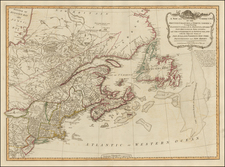A U.S. Army Corps of Engineers Plans for Upgrading A Coastal Fort. Likely Drawn for Fort Adams in Rhode Island.
Fascinating set of nine manuscript fortification plans for gun emplacements and related defenses, drawn by the from the collection of noted engineer Henry Harding, famous for his work with Greenville Dodge on the Pacific Railroad.
The plans show cross-sections, aerial views, and sketches of the emplacements and their designs. Annotations and titles show that they were used for barbette batteries, a type of gun emplacement.
It is likely that these plans were drawn for Harding's work on Fort Adams in Rhode Island, as one plan carries the date 1873. Harding's obituary says of his work that:
From 1871 to 1895, he was engaged at intervals by the United States Corps of Engineers in charge of river and harbor improvements and other work, and was wont to recall with especial pride the construction of the fortifications of Fort Adams, at Newport, R.I. in 1871-73."
During the Civil War, Fort Harding housed the Naval Academy when the loyalty of Annapolis residents was questioned. Fort Harding underwent a massive upgrade during the 1870s. As part of his upgrade, it received Rodman guns, Parrot rifles, and siege rifles, replacing most of the earlier mortars. The emplacements shown were probably designed to cope with these new weapons.
Barbette batteries were a type of artillery emplacement or gun battery that were common in the late 19th and early 20th centuries. They consists of a raised platform or a turret, known as a barbette, that is used to mount and rotate heavy guns. Barbette batteries were often used to defend fortifications, harbors, or other strategic locations. The guns mounted on the barbette were usually heavy artillery pieces, such as naval guns or coastal defense guns, that could fire over long distances and inflict significant damage on enemy ships or land-based targets.
The term "barbette" comes from the French word "barbet," which means "beard" or "barb." The name refers to the fact that the barbette is raised above the surrounding terrain, much like a beard on a face."
Henry Harding
Henry Harding was assistant engineer for the USPRR stationed in Laramie, Wyoming, where work for the railroad began in 1863. In addition to his engineering plans, he also produced a number of surveys for the UPRR in Wyoming.
Henry Harding (1837-1910) was a railroad engineer from Hartland, Vermont.
Harding worked for multiple eastern railroads during the 1850s, until he was recruited to serve as an assistant engineer for the Union Pacific under the direction of Grenville Mellon Dodge, an old friend and Chief Engineer of the railroad. Harding worked on the Union Pacific from 1865 to1870, Harding’s particular focus was the design and construction of structures such as bridges, station houses, round houses, and terminals.
After the completion of the Union Pacific / Transcontinental Railraod, Harding returned East, working briefly for the Adirondac, Housatonic, and Naguatuck Railroads, befor taking a job with the United States Engineering Corps from 1873-90, and finally retiring to Hartland, Virginia in 1890.
For a more complete account of Harding’s career, see Ellis, W.A., Norwich University, 1819-1911, Her History, Her Graduates, Her Role of Honor. Published by Major-General Grenville M. Dodge, 1911.











![Carte Du Canada ou de la Nouvelle France et des Decouvertes qui y ont ete faites . . . [Map of Canada or New France and the Discoveries Made Therein . . .]](https://storage.googleapis.com/raremaps/img/small/94450.jpg)

![Dominia Anglorum in America Septentrionali Specialibus Mappis Londini primum a Mollio… [4 maps--New England; Chesapeake, Georgia, Carolinas & Florida; and Nova Scotia…]](https://storage.googleapis.com/raremaps/img/small/60331.jpg)

![Map of the States of Massachusetts, Connecticut and Rhode Island [Large Boston Inset]](https://storage.googleapis.com/raremaps/img/small/91825.jpg)
